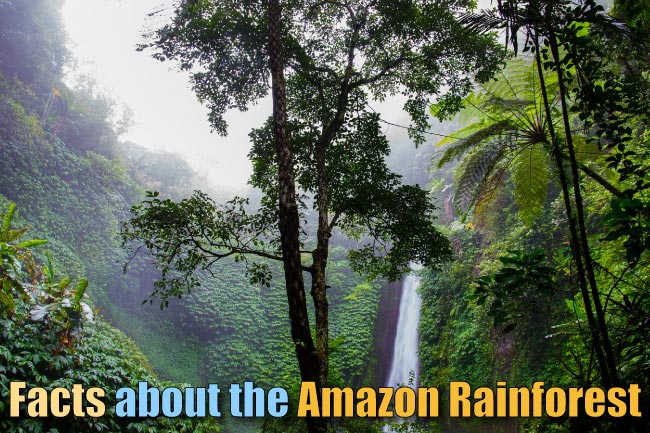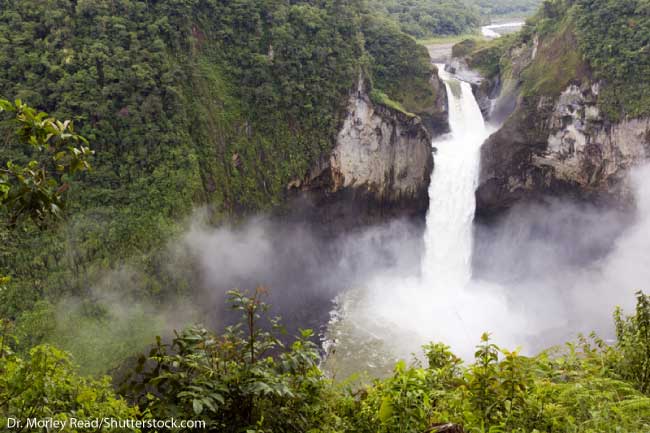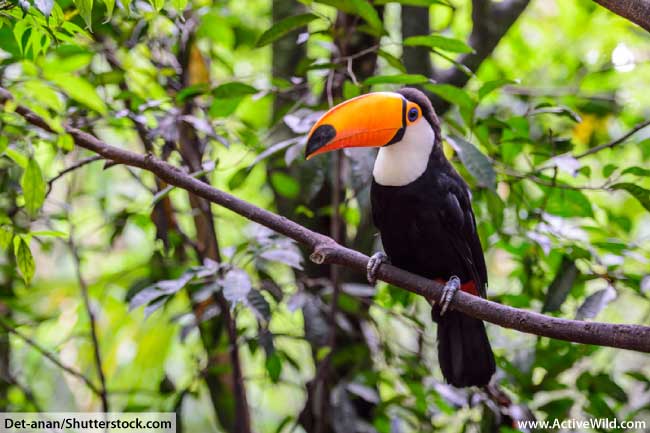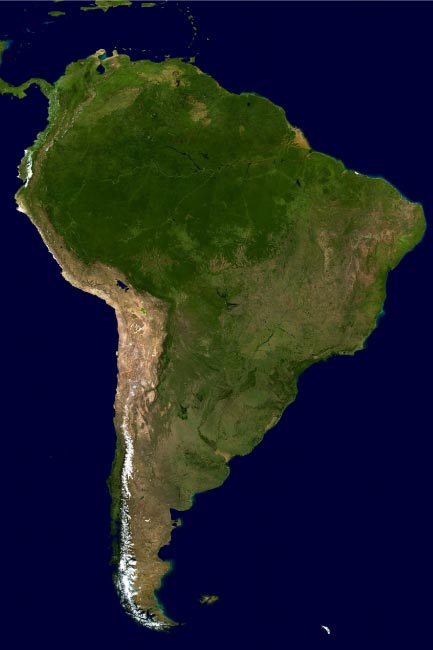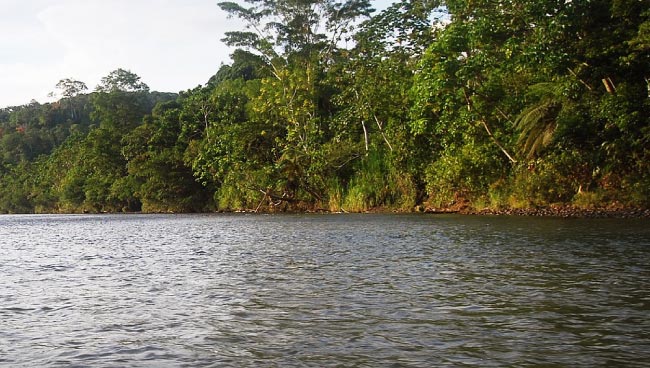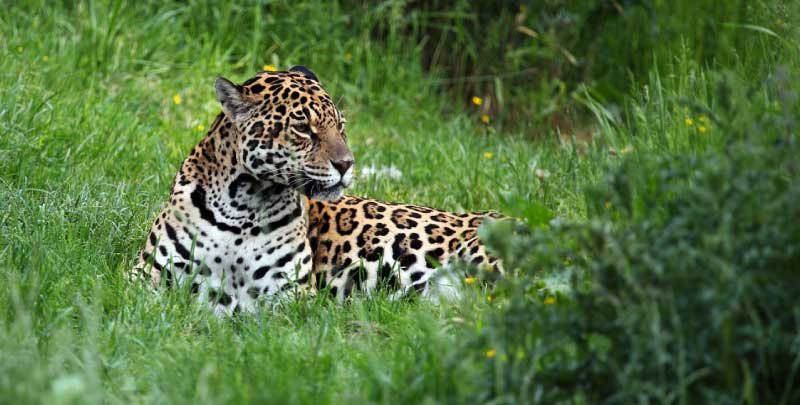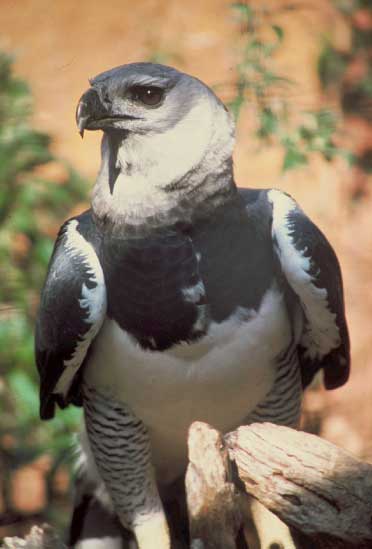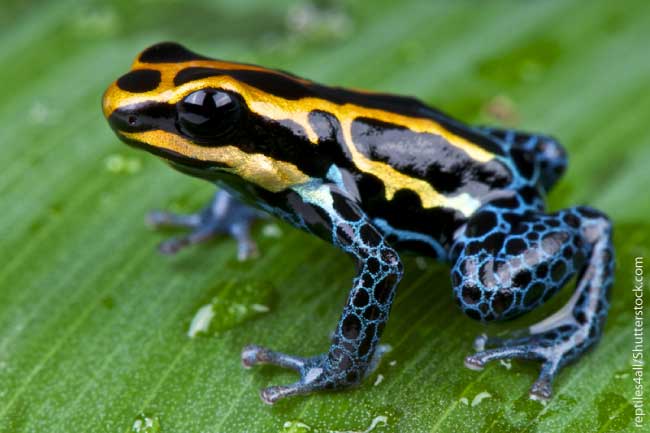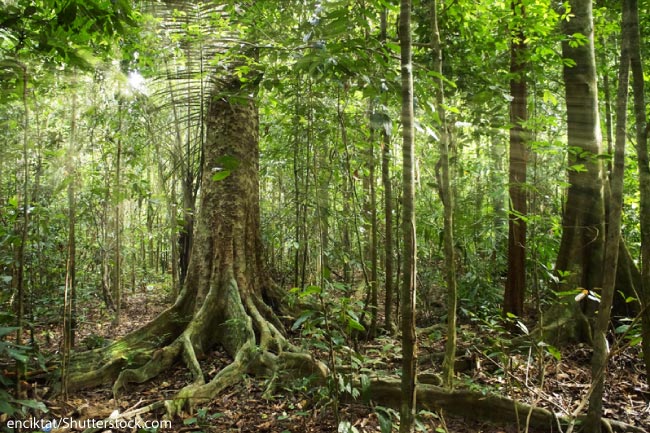This article contains facts about the Amazon Rainforest and is part of Active Wild’s Rainforest Series.
The Amazon Rainforest is the world’s biggest rainforest (you can find out just how big further down the page). It is home to a vast number of animals and plants. Many native tribes also live in the forest, far away from modern life.
The Amazon Rainforest is located in South America, in the region around the Amazon River. Over half of the forest is in Brazil.
In this tropical region, it is hot and humid all year round. In many parts of the Amazon Rainforest it rains nearly every day.
The climate creates ideal conditions for trees and plants to grow. These provide food and shelter for the region’s animals.
Life thrives in the rainforest. One tenth of all of the Earth's species are found in the Amazon Rainforest. Colourful toucans hop from branch to branch, howler monkeys call from the treetops, and tapirs rummage through the leaves on the forest floor searching for food.
However, the rainforest can also be a dangerous place. Carnivorous plants trap unwary insects, jaguars prowl through the trees, and anacondas glide through the rivers and streams.
Let’s learn more about the Amazon Rainforest…
Facts About The Amazon Rainforest: Introduction
This article starts with some amazing quick facts about the Amazon Rainforest.
We'll then find out where the rainforest is located, and learn about its climate and history.
After that, we'll take a look at the forest’s animals and plants. We’ll be discovering amazing rainforest animals such as the jaguar and the harpy eagle.
We'll also look at man’s relationship with the Amazon Rainforest. We’ll find out about rainforest tribes and why the rainforest is important to man.
Finally we'll deal with threats to the rainforest, including deforestation.
10 Particularly Amazing Amazon Rainforest Facts
It seems that everything about the Amazon Rainforest is amazing, so be prepared for some big numbers as you read about the forest and its wildlife. Here is a list of some particularly amazing facts about the Amazon Rainforest to start with...
- The Amazon Rainforest is the biggest rainforest in the world. It covers around 1.4 billion hectares.
- It is bigger than all of the other rainforests combined
- The Amazon Rainforest is twice the size of India (and India is the 7th largest country in the world!)
- It is estimated that over one fifth of the world’s bird species live here (other estimates say an even larger proportion). Over 300 species of hummingbirds live here.
- Around 1/3 of the world’s flowering plants grow here (around 80,000 species)
- An estimated 16,000 different tree species grow in the Amazon Rainforest.
- An estimated 390 billion trees grow in the Amazon Rainforest.
- 1 in 10 of all the world’s plant and animal species are found in the Amazon Rainforest.
- 2.5 million insect species are found in the Amazon Rainforest
- 1 in 5 of the world’s fish species live in the area’s rivers and streams.
Where Is The Amazon Rainforest?
The Amazon Rainforest is located in South America. It covers most of the area known as the Amazon Basin.
You can see the Amazon Rainforest In the NASA satellite image of South America below. It is the dark green area at the top of the continent.
The Amazon Basin is the huge area of land that drains into the Amazon River and its tributaries (tributaries are smaller rivers and streams that flow into a larger river).
The Amazon Rainforest is actually spread over 9 countries: Brazil, Peru, Columbia, Venezuela, Ecuador, Bolivia, Guyana, Suriname and French Guiana (although, strictly speaking, French Guiana is a part of France rather than an actual country).
Around 60% of the Amazon Rainforest is in Brazil, and 13% is in Peru.
How Big Is The Amazon Rainforest?
Very big! The Amazon Rainforest covers 2,100,000 square miles (5,500,000 square kilometres), making it the biggest rainforest in the world. It is twice the size of India, and over half the size of America.
The Amazon River
The Amazon is the world’s second longest river. It holds around 1/5 of all of the planet’s fresh water. Around 2,000 species of freshwater fish live in the Amazon River system (compare this with the 300 species found in Europe).
What Type Of forest Is The Amazon Rainforest?
The Amazon Rainforest is a tropical rainforest. Tropical rainforests are found in a region known as the tropics, which are located near the equator.
The two main characteristics of tropical rainforests is that they are hot and wet.
Most of the Amazon Rainforest is what is known as a tropical lowland rainforest. You can read more about the different types of rainforest here.
Amazon Rainforest Weather
Although there is very little seasonal variation near the equator, the Amazon does have rainy seasons, during which it rains even more than usual. This is known as a tropical monsoon climate.
Amazon Rainforest Rainfall
A lot of rain falls here.
During the rainy season, rainfall is between 60 and 180 inches.
During the ‘dry’ season, rainfall is between 30 to 100 inches.
However, because the Amazon Rainforest is so big, different parts of the forest have different climates. Some parts of the Amazon Rainforest experience dry seasons during which there is no rainfall.
Amazon Rainforest Temperature
Due to its location near the equator, there is no variation in seasonal temperatures in the rainforest. It is hot all year round. The average temperature in the Amazon Rainforest is 27°C (80.7°F).
There is more variation between day and night temperatures (a difference of between 2 to 5°C) than seasonal variations.
Animals In The Amazon Rainforest
With one in ten of the world’s species making their home in the Amazon Rainforest, you’d be right in thinking that among them are some pretty amazing animals!
Birds that live in the Amazon Rainforest include brightly-coloured macaws and toucans, hummingbirds (over 300 species of them), and the harpy eagle, the heaviest and most powerful bird of prey in the Americas, and one which happily feeds on monkeys and sloths.
Amazonian reptiles include: caimans; turtles, including the South American river turtle, the biggest freshwater turtle in South America; and snakes, including fearsome green anacondas and boa constrictors.
Amphibians include the famous – and cute – red eyed tree frog, and the famous – but not so cute – poison dart frogs (there are more than one species of these deadly creatures).
There are more insects than any other type of animal in the Amazon Rainforest. Famous examples are the leafcutter ants, who can harvest huge amounts of vegetation, but who also help it to grow, and blue morpho butterflies, whose colours are so bright they can be seen by pilots flying over the forest.
Mammals include primates such as howler monkeys and spider monkeys. Anteaters hoover up large numbers of ants and termites, but not so many that the insects can’t rebuild their nests (allowing the anteater to come back again!). One of the rainforest’s most famous inhabitants is the jaguar. The largest cat species in the Americas (and the third biggest species of cat in the world), this stealthy animal is a master at ambush hunting.
Plants Of The Amazon Rainforest
An incredible number of plants grow in the Amazon Rainforest. These range from carnivorous pitcher plants that trap and eat their insect prey; towering kapok trees that grow up to 70 m (230 ft.) high; and Amazonian water lilies whose leaves can be over 2 metres in diameter.
The most common tree in the Amazon Rainforest is the Euterpe precatoria, a pine tree which grows up to 20 metres tall. Its fruit are edible, and are eaten by native people.
Other common trees include the rubber tree, which produces latex used to make rubber, and walking palms, which have unusual, stilt-like roots.
Plants in the Amazon rainforest don’t always grow on the ground! Many species actually grow on other plants. Epiphytes, which include orchids and bromeliads, grow on trees, usually in the canopy layer. The epiphytes growing in a single tree can weigh several tonnes.
Tribes In The Amazon Rainforest
Humans have inhabited the Amazon Rainforest for around 10,000 years. Today it is home to around one million native people, grouped in several hundred tribes. Most of these tribes are in contact with the modern world, but there are some who choose to retain a traditional way of life deep in the forest. These are known as ‘uncontacted’ tribes.
Why The Amazon Rainforest Is Important?
The Amazon Rainforest is important in many ways.
It is home to a vast number of species, many of which are not found anywhere else. It’s also home to native tribes and many other people, many of whom live sustainably within or around the forest.
Many medicines are produced using ingredients found in the rainforest.
The forest helps to regulate weather patterns. Studies have shown that less rain falls on deforested areas.
The plants of the Amazon Rainforest hold vast stores of carbon which, if released due to areas of the forest being cleared, is harmful to the atmosphere.
If harvested responsibly, the Amazon Rainforest can produce timber, food and many other products beneficial to man.
Threats To The Amazon Rainforest
Deforestation is the primary threat to the Amazon Rainforest. Most forest clearance is carried out to make way for agricultural land. Crops such as soya beans are grown, and cattle are allowed to graze.
Trees are cut down to make roads that allow loggers to reach deep into the forest. Valuable timbers are taken out of the forest. The roads to the previously unreachable parts of the forest are then used by farmers who clear more land for their cattle.
Each year more and more of the Amazon Rainforest is lost due to deforestation. The land cleared of trees is visible with the naked eye from space.
Facts About The Amazon Rainforest Conclusion
We hope you’ll agree that the Amazon Rainforest is an amazing place. Teeming with life, it is a place of incredible beauty that needs to be protected.
What was the most amazing thing that you learned about the rainforest? Was it its size? The number of different species that live there? The animals and tribes that call it home?
So many facts about the Amazon Rainforest are amazing that it’s hard to know where to start!
Perhaps one day you’d like to visit the Amazon Rainforest yourself!
If you want to learn more about rainforests you can start at our ultimate guide to rainforests.
If you enjoyed this article, please feel free to link to it, and share it on social media using the share buttons provided.

